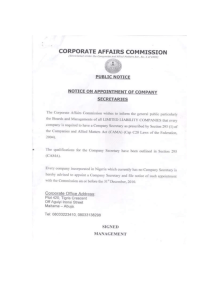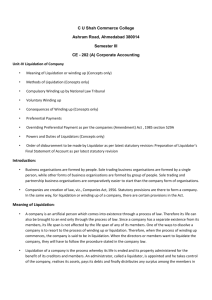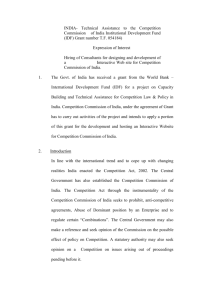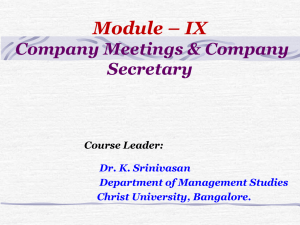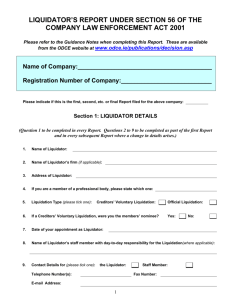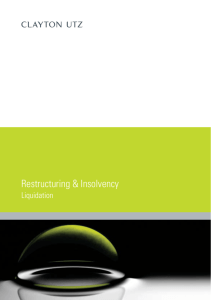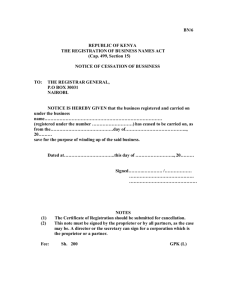Procedural Issues in Company Liquidation and Receivership
advertisement
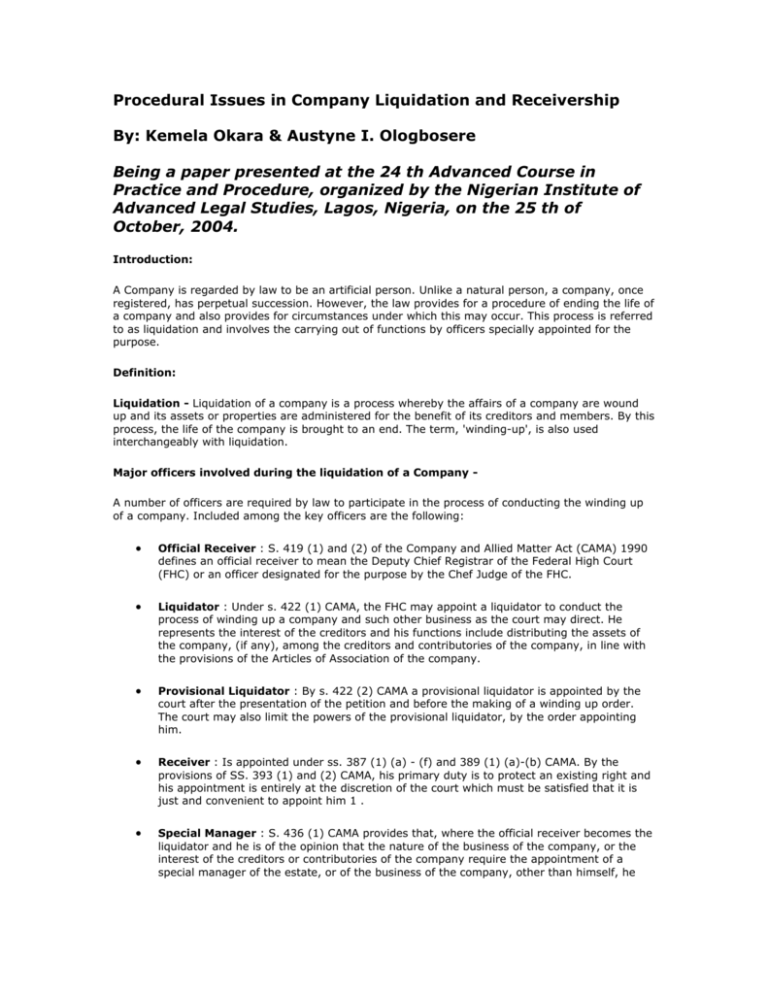
Procedural Issues in Company Liquidation and Receivership By: Kemela Okara & Austyne I. Ologbosere Being a paper presented at the 24 th Advanced Course in Practice and Procedure, organized by the Nigerian Institute of Advanced Legal Studies, Lagos, Nigeria, on the 25 th of October, 2004. Introduction: A Company is regarded by law to be an artificial person. Unlike a natural person, a company, once registered, has perpetual succession. However, the law provides for a procedure of ending the life of a company and also provides for circumstances under which this may occur. This process is referred to as liquidation and involves the carrying out of functions by officers specially appointed for the purpose. Definition: Liquidation - Liquidation of a company is a process whereby the affairs of a company are wound up and its assets or properties are administered for the benefit of its creditors and members. By this process, the life of the company is brought to an end. The term, 'winding-up', is also used interchangeably with liquidation. Major officers involved during the liquidation of a Company A number of officers are required by law to participate in the process of conducting the winding up of a company. Included among the key officers are the following: Official Receiver : S. 419 (1) and (2) of the Company and Allied Matter Act (CAMA) 1990 defines an official receiver to mean the Deputy Chief Registrar of the Federal High Court (FHC) or an officer designated for the purpose by the Chef Judge of the FHC. Liquidator : Under s. 422 (1) CAMA, the FHC may appoint a liquidator to conduct the process of winding up a company and such other business as the court may direct. He represents the interest of the creditors and his functions include distributing the assets of the company, (if any), among the creditors and contributories of the company, in line with the provisions of the Articles of Association of the company. Provisional Liquidator : By s. 422 (2) CAMA a provisional liquidator is appointed by the court after the presentation of the petition and before the making of a winding up order. The court may also limit the powers of the provisional liquidator, by the order appointing him. Receiver : Is appointed under ss. 387 (1) (a) - (f) and 389 (1) (a)-(b) CAMA. By the provisions of SS. 393 (1) and (2) CAMA, his primary duty is to protect an existing right and his appointment is entirely at the discretion of the court which must be satisfied that it is just and convenient to appoint him 1 . Special Manager : S. 436 (1) CAMA provides that, where the official receiver becomes the liquidator and he is of the opinion that the nature of the business of the company, or the interest of the creditors or contributories of the company require the appointment of a special manager of the estate, or of the business of the company, other than himself, he may apply to the court for an order appointing such a manager to act during such time and with such powers as the court may direct. The presence of the above officers ensures the performance of a proper liquidation of the affected company. Governing Law The Laws regulating liquidation or winding up are contained in (Part XV) of CAMA and the Companies Winding-Up Rules 2001. However, winding-up regulations are not limited to the aforementioned two; such rules, relating to the banking sector, are also contained in the Banking and Other Financial Institutions Decree No. 25 (BOFID) (now Act) 1991. Modes of Winding-up S. 401 of CAMA provides for the following modes in effecting the winding-up of a company: by the Court; or voluntary; or subject to the supervision of the court. As regards a bank, BOFID provides that, where the management of a failing or failed bank has been assumed by the Central Bank or any other person appointed for that purpose, the Central Bank may, among other things, make an order revoking the licence of the failed bank. The affected bank is obliged to apply to the Federal High Court - within 14 days - for an order to wind-up. Where the failed bank neglects to make the application, the Central Bank is then empowered to make this application and furthermore, to appoint the Nigerian Deposit Insurance Corporation or any other person as the official receiver or provisional liquidator of the failed bank 2 . Commencement of winding up This depends upon the mode of liquidation. Where it is a winding up by court, liquidation is deemed to commence before the presentation of a petition to the court, at the time when a resolution was passed for the voluntary winding up of the company 3 . In any other case, liquidation is deemed to commence at the time of presentation of the petition for winding up 4 . Which Court has Jurisdiction to wind-up? The Court having jurisdiction to wind-up a company is the Federal High Court, within whose area of jurisdiction the registered office or head office of the company is situate 5 . Winding-up by the Court The cases in which a company may be wound up by the court are if: the company has by special resolution resolved that the company be wound-up by the court; or default is made in delivering the statutory report to the Commission (CAC) or in holding the statutory meeting; or the number of the members is reduced below two; or the company is unable to pay its debts; or the court is of the opinion that it is just and equitable that the company be wound up 6 . Voluntary winding-up This occurs in the following instances: When the period fixed by the articles for the duration of the company express; or on the occurrence of any event which the articles provide shall lead to the dissolution of the company and the company has at a general meeting, passed a resolution for the company to be would up voluntarily; and If the company passes a special resolution that the company be wound up voluntarily 7 . This may occur, for instance, where a segment of the members of the company are unfairly treated or there is a deadlock in the management of the company. Winding-up subject to supervision of court This occurs where a company passes a resolution for winding up and makes a petition to the court to supervise the process. The court may then order that the winding up continue, but subject to such supervision of the court and with such liberty for creditors, contributories or others to apply to the court, and generally on such terms and conditions, as the court thinks just 8 . Persons eligible to petition for winding up Petitions for winding up may be made by the following: the company; or a creditor, including a contingent or prospective creditor of the company; or a contributory [a person liable to contribute to the assets of the company in the event of its being would up]; or the official receiver; or a trustee in bankruptcy to or a personal representative of a creditor or contributory; or the C.A.C., where it thinks it expedient in the public interest to wind up the company and it appears to the court that it is just and equitable to do so; or A receiver, if authorized by the instrument under which he was appointed; or By all or any of the above parties, together or separately 9 . Procedure The procedure involved in winding up varies, according to the type of winding up chosen. The difference in the procedure occurs mainly in the principal actors involved and also in the status of the company at the time of liquidation. For instance, winding up is categorized into two: Members' Voluntary Winding up and Creditors' Voluntary Winding up. In the former, the members propose a winding up and make a statutory declaration of "Solvency", stating that, after enquiry into the affairs of the company and in their opinion the company will be able to pay its debts in full within such period, not exceeding 12 months from the start of winding up 10 . Under this situation, the members of the company can choose who the liquidator of the company will be. In the latter however, no declaration of solvency is made and separate meetings of the creditors and the members of the company are held 11. Though the members and the creditors are entitled to nominate liquidators at their separate meetings, the creditors' nominee is accepted, where the members and the creditors nominated different persons to liquidators 12 . However, any member or director or creditor of the company may apply to the court, within 7 days after the creditors made their nomination, for an order for the members 'nominee to act instead of or jointly with the creditors' nominee. An application for winding up is made by way of petition in prescribed forms with such variations as the circumstances require and shall be verified by affidavit. The petition, except presented by the company, shall be served on the company at its registered office or its principal place of business, by leaving a copy of the petition with any member, officer or servant of the company or, where no such member or servant is found, by leaving it on the premises or by serving it in such manner as the court may direct. Where the company is being wound up voluntarily, the petition shall be served upon the liquidator, if any, appointed for the purpose of winding up the company. Any person who intends to appear at the hearing of the petition shall give notice of his intention. The company, any creditor and contributory may attend the hearing of the petition and on the hearing of the petition, the court may dismiss it or adjourn the hearing conditionally or unconditionally or make any interim order or other order it deems fit: s. 411 (1). In cases where the petition is presented on the ground of default in delivering the statutory report to the Commissioner or in holding the statutory meeting, the court may, instead of making a winding up order, direct that the report be delivered or the meeting be held, and make an order directing the cost to be paid by the persons who, in the opinion of the court, are responsible for the default: s. 411 (3). The procedure for winding up is as follows: (a) Members' Voluntary Winding Up [s.464 - s.470 CAMA] The company calls a general meeting where one or more liquidators are appointed 13 ; after the appointment of the liquidator, the powers of the directors shall cease, except as far as the company in general meeting or the liquidator sanctions the continuance thereof 14; subject to any arrangements with its creditors, the company is empowered to fill any vacancy that occurs in the position of the liquidator by reason of the death or resignation or otherwise of the liquidator. A general meeting for the purpose of filling the vacancy may be called by any contributories or by the continuing liquidators, if they be more than one 15 ; where the liquidator is of the opinion that the company will not be able to pay up its debt within the period stated in the solvency declaration, he is obliged to summon a meeting of the creditors and lay before them, a statement of the assets and liabilities of the company 16 . Here, the winding up will be treated as if it were a creditors' winding up 17 ; where the winding up will continue for more than one year, the liquidator is obliged to summon a general meeting of the company at the end of the first year from the commencement of the winding up and of each succeeding year, or at the first convenient date within three months from the year or such other date the C.A.C. shall allow; laying before the meeting, an account of his dealings and the conduct of the winding up during the preceding year 18 ; when the affairs of the company have been wound up, the liquidator shall call a general meeting by notice published in gazette and in some newspaper printed in Nigeria and circulating in the locality where the meeting is being called, and lay an account - giving an explanation thereof - of the conduct of winding up and how the property was disposed 19 ; and within 7 days, send a copy of the account to the C.A.C. 20 . as soon as the winding up is completed, the liquidator shall prepare and send to every member of the company, financial accounts showing the conduct of the winding up and the results of any trading done by the company; and convene a general meeting to lay before the members and explain the accounts 21 ; and within 28 days after the meeting, forward to the C.A.C. for registration, copies of the account and a statement of the meeting and the date it was held 22 ; prior to the laying of the accounts before the general meeting, the account should be audited by the auditor (s) of the company, who are obliged to also annex a report to the effect that, in their opinion and to the best of their information, they obtained all the information necessary for the audit, and proper records were maintained by the liquidator, and also that the accounts were in accordance with the books and records and gave all the information required by the CAMA and also gave a true and fair view of the matters stated in such accounts 23 ; the liquidator is to keep the books and the papers of the company and of the liquidator for a period of 5 years from the dissolution of the company. Thereafter, such documents may be destroyed, except the C.A.C. directs otherwise 24 . (b) Creditors' Voluntary Winding up [s.472 - s.478CAMA] For the purpose of proposing a voluntary winding up, the company, shall by notice published once in the gazette and at least once in two newspapers printed in Nigeria and circulating in the district where the registered office or principal place of business is located, and by notices sent by post simultaneously to the creditors and the members of the company, summon a meeting of the creditors of the company for the same day as that on which the meeting for the members shall be held, or for the next day following. The directors shall appoint one of their number to preside at the meeting 25 ; the creditors' choice for a liquidator is accepted, where the members and the creditors nominate different persons to be liquidator; though any member or director or creditor of the court may apply to the court, within 7 days after the creditors made their nomination, for an order for the person nominated by the members as liquidator to act instead of or jointly with the person nominated by the creditors; a vacancy occurring in the office of the liquidator, by reason of the death or resignation or otherwise of the liquidator, may be filled by the creditors, except the liquidator was appointed by the court or under the direction of the court 26 ; where the winding up will continue for more than one year, the liquidator is to summon a general meeting of the company at the end of the first year from the commencement of the winding up and of each succeeding year, or at the first convenient date within 3 months form the year or such other date as the Commission shall allow; laying before the meeting, an account of his dealings and the conduct of the winding up during the preceding year 27 ; as soon as the affairs of the company have been wound up, the liquidator shall call a general meeting, by notice published in the gazette and in some newspaper printed in Nigeria and circulating in the locality where the meeting is being called, and lay an account - giving an explanation thereof - of the conduct of the winding up and how the property was disposed of 28 ; and within 7 days, send a copy of the account to the Commission 29 , provided that if a quorum is not present at the meeting, the liquidator shall make a return that the meeting was duly summoned and that no quorum was formed; when the Commission receives the account and the return, it registers them and at the expiry of 3 months after the registration of the accounts and the returns, the company is deemed to be dissolved 30 . (c) Winding Up Subject to the Supervision of the Court [s.486 - s.490 CAMA] A company may pass a resolution to voluntarily wind up a company and may petition the court to supervise the winding up. In this case, the court may so order, and with such liberty for creditors, contributories and others to apply to the court, and generally on such terms and conditions as the court thinks fit 31 ; a petition for the continuance of a voluntary winding up subject the supervision of the court shall be deemed to be a petition for winding up by the court, for the purposes of conferring the court with jurisdiction. It should be noted that, by the provision of section 491 (1) CAMA, in every mode of winding up, the liquidator is obliged to publish in the gazette and in 2 daily newspapers, within 14days, a notice of his appointment and deliver the same notice to the Commission for registration, in such form as the Commission may from time to time require. Consequences of Winding up The consequences of winding up include the following: Under a voluntary winding up, from the commencement of the winding up, the company shall cease to carry on business, except as far as may be required for the purposes of concluding the winding up. However, the corporate state and corporate powers of the company shall continue until the company is dissolved: s.460 CAMA. Any transfer of shares, not made to or without the authority of the liquidator, and any change in status of the members of the company, made after the commencement of the winding up, shall be void: s.461 CAMA. In a winding up by the court, any disposition of the property of the company, including things in action, or any alteration in the status of the members of the company, made after the commencement of the winding up, shall be void, unless the court otherwise differently orders:s413 CAMA. Where a winding up order is made or a provisional liquidator appointed no action or proceedings shall be proceeded with or commenced against the company, except by leave of the court and on such terms as the court may impose: s.417 CAMA. Where a company is being wound up subject to the supervision of the court, any attachment, sequestration or execution put in force against the estate or effects of the company after the commencement of the company shall be void: s.497 CAMA. The position of a Receiver in a Company Liquidation The appointment of a receiver is one of the main remedies available to debenture holders to realize their security. The primary duty of the receiver is to protect the interest of the debenture holder. A company may borrow money for the purposes of advancing its business and may change or mortgage its undertakings or assets and issue "debentures", which has been defined to mean: "..a written acknowledgement of indebtedness by the company, setting out the terms and conditions of the indebtedness, and include debenture stock, bonds and any other securities of the company, whether constituting a charge on the assets of the company or not.." 32. Disqualification of a Receiver By the provisions of s.387 (1) (a) - (f), the following may not be appointed or act as receivers of any property or undertaking of a company: an infant; any person found by a competent court to be of unsound mind; a body corporate; an undischarged bankrupt, unless he shall have been given leave to act as a receiver or manager of the property or undertaking of the company by the court by which he was adjudged bankrupt; a director or auditor of the company (conflict of interest); any person convicted of any offence involving fraud' dishonesty, official corruption or moral turpitude and who is disqualified under s. 254 of CAMA (offence committed in connection with the promotion, formation or management of a company). Who may appoint a receiver By the provision of s.209 (1) (a) - (d) CAMA, a receiver may be appointed by the following: by the trustee of the trust deed covering the debenture; the holders of the debentures of the same class containing power to appoint; or debenture holders having more than one one-half of the total amount owing in respect of all the debentures of the same class; or the court on the application of the trustee. Notice of appointment of a receiver By s. 392 (1) CAMA, the C.A.C. must be notified of the appointment of a receiver within 14 days of the appointment. Every invoice, order for goods, or business letter issued by or on behalf of the company or receiver, on which the name of the company appears, shall bear a statement that a receiver has been appointed. Under s. 396 (1)(a)CAMA, where the receiver is appointed over the whole or substantially the whole of the property of the company on behalf of holders of the debentures of the company secured by a floating charge, the receiver must notify the company and state the terms of the appointment. Where a person obtains an order for the appointment of a receiver under any powers contained in any instrument, he must within 7 days of the order or appointment, give notice to the C.A.C. for entry in the register of charges:s.206(1). Effects of the appointment of a receiver From the date of appointment of the receiver, the powers of the liquidators and directors in a members voluntary winding up, to deal with the property of the company over which the receiver is appointed, cease, until the receiver is discharged:s.393 (4) CAMA. Upon the appointment of the receiver, the floating charges crystallize and become fix charges, thus the company can no longer deal with the assets without the consent of the receiver. END NOTES (Onuora v Onuora) [2001]1NWLR [part 641] 386-396; (Anatogu v Anatogu) [1998]6 NWLR [part 552]42-64. 1. 2. 3. 4. 5. 6. s.34 (1); s. 36(b); s.38 (1), (2), (3). s. 415 (1) CAMA. s. 425 (2). s. 407 (1) CAMA; s.38 (1) (2), (3). BOFID s.408 (a)-(e) CAMA. s.457 (a)-(b) CAMA. 7. 8. 9. 10. 11. 12. 13. 14. 15. 16. 17. 18. 19. 20. 21. 22. 23. 24. 25. 26. 27. 28. 29. 30. 31. s. 486 CAMA. s. 410 (a)-(h) CAMA. s.462 (1), (2) CAMA. s. 472(1).CAMA s. 473 (1) s.464 (1) CAMA. s. 464 (2) CAMA. s.465 (1) CAMA. s. 466 (1) CAMA. s. 469 CAMA. s. 467 (1) CAMA. s. 468 (1), (2) CAMA. s. 468 (3) CAMA. s. 470 (3) CAMA. s. 470 (4) CAMA. s. 470 (6) (a) & (b) CAMA. s. 470 (8) CAMA. s. 472 (1), (2), (3) (b) CAMA. s. 476 CAMA. s. 477 (1) CAMA. s. 478 (1), (2) CAMA. s. 478 (3) CAMA. s. 478 (4) CAMA. s. 486 CAMA. s. 650 CAMA.
